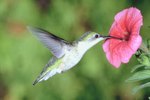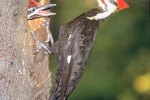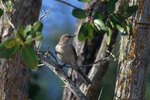
The yellow-billed hornbill, endemic to Africa, is characterized by a large, distinctive and curving yellow bill. Fans of the Disney movie "The Lion King" would recognize the character of Zazu, voiced by actor Rowan Atkinson, as a yellow-billed hornbill. Two subspecies of yellow-billed hornbill exist: the Eastern yellow-billed hornbill (Tockus flavirostris) and the Southern yellow-billed hornbill (Tockus leucomelas). The differences between these two subspecies are minimal, seen in the variance in color around the respective specimens' eyes.
Range

Yellow-billed hornbills are found along the southern horn and in the eastern countries of Africa, ranging in the east from Djibouti down to Tanzania. Although other species of hornbill are listed as endangered or vulnerable on the IUCN Red List of Threatened Species, both the eastern and southern yellow-billed hornbills fall in IUCN's category of Least Concern. Their population is decreasing, but their far-reaching range makes them far from endangered. The birds are so common that in many national parks in Africa they've achieved the nickname "flying bananas".
Nesting

The yellow-billed hornbill likes dry, thorny regions as well as deciduous woodlands and scrublands. The hornbills use natural holes in hollow or abandoned trees to nest. The female yellow-billed hornbill will seal herself inside a tree using her own feces and will incubate three to four eggs over a 24-day period. During this time the male hornbill will feed her through a small opening. Juvenile yellow-billed hornbills take about 45 days to mature.
Diet
When a juvenile hornbill leaves the nest, he begins foraging near his nesting tree with with his parents. Foraging is the way the hornbill finds all of its food. At times, the yellow-billed hornbill will seek out insects in trees but mostly feeds on the ground. Omnivorous, the yellow-billed hornbill will eat insects, fruit, seeds, small animals, lizards and sometimes snakes. The hornbill will pick up a piece of food with his oversize bill, then toss his head backward, swallowing the food whole.
Sociability

Hornbills live together, either in pairs or in small nesting groups. Yellow-billed hornbills are most active in social groups at dawn and dusk. Often, several hornbills will pick up the chorus, with the "wuk wuk" of their call rising in cacophany, then fading, then beginning again. When in a group setting, one hornbill will begin the call and other males will join him, opening their wings and bowing their heads in a colorful display of plumage.
References
- Sabi Sabi: Southern Yellow-billed Hornbill
- African Protected Area Conservation and Science, Volume 8: Development and Behavior of a Yellow-billed Hornbill (Lophoceros Flavirostris Leucomelas) Chick; O.P.M. Prozesky
- Journal of African Ornitholofy: Artificial Nesting Devices in Southern Africa; W. Buttiker
- National Geographic Complete Birds of the World; Tim Harris
- IUCN Red List of Threatened Species: Tockus Flavirostris
Resources
Photo Credits
-
Anup Shah/Photodisc/Getty Images




